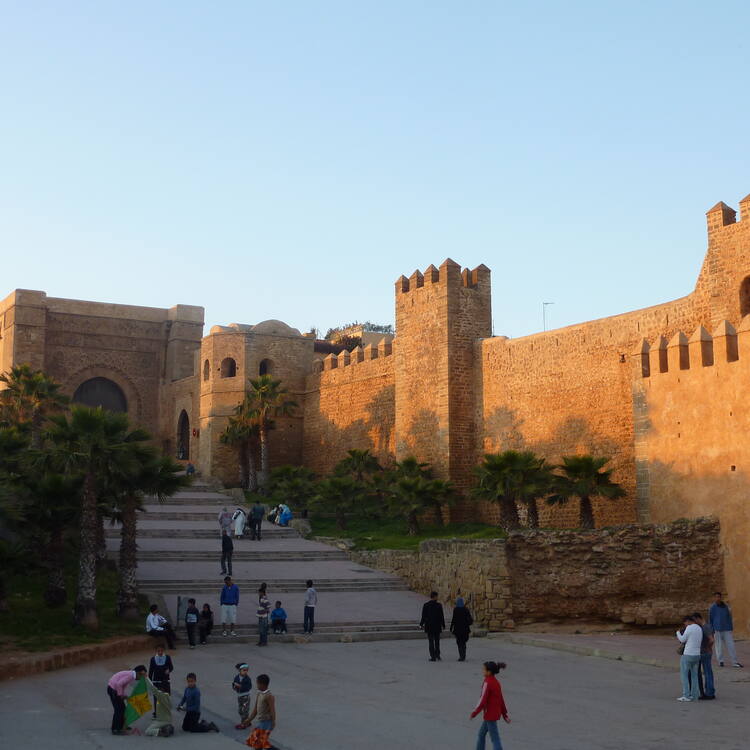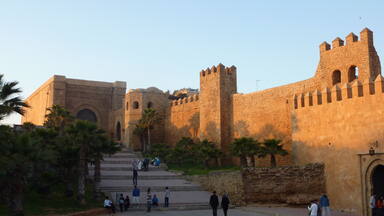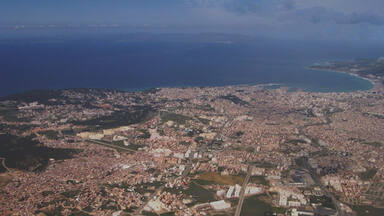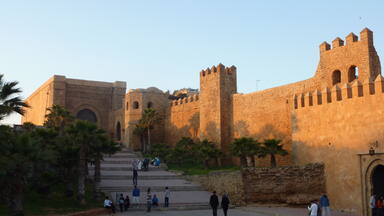Rabat, Modern Capital and Historic City: a Shared Heritage
Rabat, Modern Capital and Historic City: a Shared Heritage
Located on the Atlantic coast in the north-west of Morocco, the site is the product of a fertile exchange between the Arabo-Muslim past and Western modernism. The inscribed city encompasses the new town conceived and built under the French Protectorate from 1912 to the 1930s, including royal and administrative areas, residential and commercial developments and the Jardins d’Essais botanical and pleasure gardens. It also encompasses older parts of the city dating back to the 12thcentury. The new town is one of the largest and most ambitious modern urban projects built in Africa in the 20th century and probably the most complete. The older parts include Hassan Mosque (begun in 1184) and the Almohad ramparts and gates, the only surviving parts of the project for a great capital city of the Almohad caliphate as well as remains from the Moorish, or Andalusian, principality of the 17thcentury.
Description is available under license CC-BY-SA IGO 3.0
Rabat, capitale moderne et ville historique : un patrimoine en partage
Située sur la façade atlantique, au nord-ouest du Maroc, Rabat est le résultat d’un dialogue fructueux entre le passé arabo-musulman et le modernisme occidental. Le site comprend la « ville nouvelle », conçue et construite sous le Protectorat français de 1912 aux années 1930, incluant la résidence royale, des administrations coloniales, des ensembles résidentiels et commerciaux, le jardin d’Essais – botanique et d’agrément.. On y trouve aussi des parties anciennes de la ville qui remontent parfois au XIIe siècle. La « ville nouvelle » représente un des plus grands et plus ambitieux projets urbains du XXe siècle en Afrique, probablement le plus complet. Les parties anciennes abritent la mosquée Hassan (début de la construction en 1184) ainsi que les remparts et portes almohades, seuls vestiges subsistant d’un grand projet de ville capitale du califat almohade. On y trouve aussi des vestiges de la principauté morisque, ou andalouse, du XVIIe siècle.
Description is available under license CC-BY-SA IGO 3.0
Rabat, capital moderna y ciudad histórica
Situada en el litoral atlántico, al noroeste de Marruecos, la ciudad de Rabat es producto de una simbiosis fecunda de la tradición árabe-musulmana y del modernismo occidental. El sitio inscrito en la Lista del Patrimonio Mundial abarca la llamada “ciudad nueva”, proyectada y construida entre 1912 y el decenio de 1930, en tiempos del protectorado francés, y también algunas zonas más antiguas del casco urbano que datan del siglo XII en algunos casos. La “ciudad nueva”, que representa uno de los proyectos urbanísticos más vastos y ambiciosos realizados en África en el siglo XX y, probablemente, uno de los más completos, abarca el palacio real y conjuntos arquitectónicos administrativos, residenciales y comerciales, así como el Jardin d’Essais, parque y jardín botánico a la vez. En el casco antiguo se hallan: la mezquita de Hassan, cuya construcción comenzó en 1184; las murallas medievales y sus puertas, únicos restos de la gran capital proyectada por el califato almohade; y vestigios moriscos y andaluces que datan del siglo XVII principalmente.
source: UNESCO/CPE
Description is available under license CC-BY-SA IGO 3.0
ラバト:近代都市と歴史的都市が共存する首都
モロッコ北西、大西洋岸に位置する首都ラバトは、20世紀前半のフランス保護領時代に計画的に改造された都市。アフリカ北西部のマグレブ地方特有の旧市街のデザインが尊重され、その南側に新市街が組み込まれている。宮廷や住宅、商業地区、庭園などからなる新市街は、20世紀のヨーロッパ的都市理念が周辺に伝播した顕著な事例。旧市街には12世紀から17世紀のイスラム王朝時代の建物も残り、多様な建築要素や、過去と現在の建築物が見事に調和し、洗練された都市を形成している。source: NFUAJ
Rabat, moderne hoofdstad en historische stad: een gedeeld erfgoed
Rabat ligt aan de Atlantische kust in het noordwesten van Marokko. De stad is het product van een vruchtbare uitwisseling tussen het Arabo-islamitische verleden en het westerse modernisme. Het gebied omvat de nieuwe stad en oudere delen. Het nieuwe gedeelte werd ontworpen en gebouwd onder het Franse protectoraat van 1912 tot 1930. Hieronder vallen koninklijke, residentiële en commerciële bebouwingen , waaronder de botanische tuinen en lusthoven Jardins d’Essais. In het oude deel van Rabat bevinden zich de Hassan moskee (waarmee men begon in 1184), de Almohaden wallen en poorten en overblijfselen uit het Moorse, of Andalusische, prinsdom van de 17e eeuw.
Source: unesco.nl
Outstanding Universal Value
Brief synthesis
Rabat bears witness to a capital city conceived at the time of the Protectorate, at the beginning of the 20th century. The project successfully adapts modernist town planning and architectural values within the context of the Maghreb, whilst incorporating them into the framework of the ancient city with its many historic and heritage components. The result embodies the emergence of a distinctive architectural and decorative style which is characteristic of contemporary Morocco.
The well-conserved modern city has been rationally designed, and contains quarters and buildings with clearly defined functions and significant visual and architectural qualities. The modern city is characterised by the coherence of its public spaces and by the putting into practice of public health ideas (services, role of vegetation, etc.). The habitat is illustrated by quarters with clearly asserted identities: the Medina and the Kasbah, the residential quarters and the middle-class housing of the modern city, and finally the neo-traditional quarter of Habous de Diour Jamaâ. The city includes a full range of monumental, architectural and decorative elements from the various earlier dynasties. The modern city of Rabat tangibly expresses a pioneering approach to town-planning, which has been careful to preserve historic monuments and traditional housing. The reappropriation of the past and its influence on 20th century town planners and architects has resulted in a distinctive and refined urban, architectural and decorative synthesis. The property as a whole makes visible a heritage shared by several major cultures of human history: ancient, Islamic, Hispano-Maghrebian and European.
Criterion (ii): Through its urban ensemble, its monuments and its public spaces, the modern city of Rabat shows respect for, and draws inspiration from, the earlier Arabo-Muslim heritage. It bears outstanding testimony to the diffusion of European ideas in the early 20th century, their adaptation to the Maghreb, and in return the influence of local, indigenous styles on architecture and decorative arts.
Criterion (iv): The city constitutes an outstanding and fully realized example of modern town planning, for a 20th century capital city, achieved by functional territorial organisation which incorporates the cultural values of the past in the modernist project. The synthesis of decorative, architectural and landscape elements, and the interplay between present and past, offer an outstanding and refined urban ensemble.
Integrity
The various dimensions of the integrity of the property are satisfactory: the balance between the urban plan of the modern city and the conservation of its many earlier urban strata, the integrity of the habitation in the various quarters, the integrity of the archaeological ensembles, the adequately conserved fortifications of the Almohad wall, etc. However, it is necessary to carefully monitor the impact of the major works being considered outside the property, particularly with regard to the view of the property and of the River Bou Regreg from the Kasbah site which overlooks them.
Authenticity
Many individual elements are indicated in the inventory descriptions, and it is clear that the elements forming the property have a high level of authenticity, particularly as regards perceived urban authenticity. More generally, the conditions of authenticity in urban and monumental terms are satisfactory. However, quantified data concerning the individual authenticity of the residential buildings would be a useful addition to the inventory system already in place.
Protection and management requirements
The measures to protect the urban ensembles, the monuments and the archaeological sites are in place. Because of its introduction from an early date, the legislation which applies to the city of Rabat has made a fundamental contribution to the history of its conservation as an urban ensemble which is both ancient and modern. The new measures announced concerning more extensive urban protection and the protection of the urban landscape formed by the property are currently being promulgated.
The management structure is in place, and is coordinated by the new overarching authority of the Rabat Cultural Heritage Preservation Foundation. It relies, with regard to technical and scientific matters, on the National Heritage Directorate, and on various other bodies responsible for specific elements of the property, together with the services of the Municipality and Prefecture of Rabat. A large number of qualified staff are assigned to the conservation and management of the property. All the regulatory and organisational provisions, and the 5-Year Action Programme, are set out in the Management Plan.







